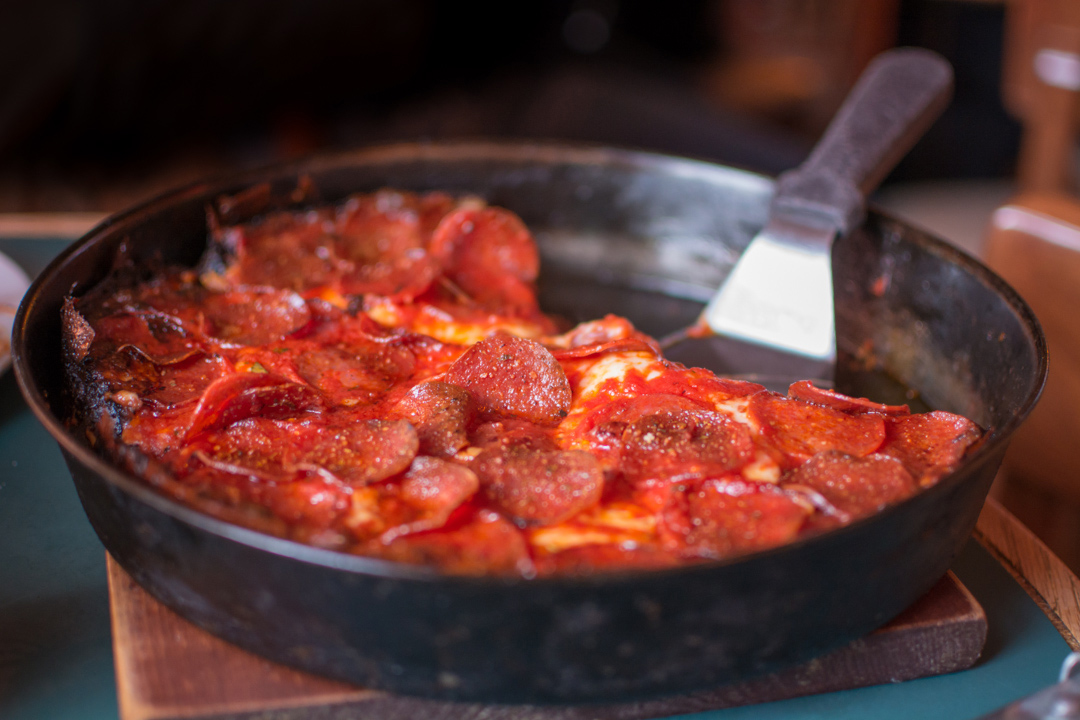
Take a bite of a great pizza, and the edge should hit you with unexpected flavors: nutty, sweet, and bitter. That’s what makes caramelized pizza crust so special; by cooking at high heat, ordinary cheese and dough are transformed into golden, crispy perfection. Pequod’s in Chicago has perfected this technique, creating flavors you just won’t find at your average pizza joint.
Understanding Caramelized Pizza Crust
When sugars heat up, they undergo a nonenzymatic reaction that turns them brown and creates complex flavors — sweet, nutty, and slightly bitter. This isn’t just a simple browning process; it’s a series of chemical changes that make great pizzas taste the way they do. The process happens in stages: sugars melt, foam, lose water, and transform chemically, creating aromatic molecules that give you those unforgettable burnt-sugar, fruity, and buttery notes that make your taste buds so happy.
Heat is a big factor in this process, as different sugars need different temperatures to caramelize. Fructose starts caramelizing at 230 F, but glucose and sucrose need temperatures closer to 320 F. This means that pizza makers need to know their stuff and control their ovens just right to create that perfect edge. Many chefs place cheese right up to the rim of the pan, where it caramelizes against the hot metal, forming a crispy edge that reinforces each slice.
The caramelization process changes both how the crust feels and tastes. Regular pizza crust is soft and chewy, but caramelized crust delivers a satisfying crunch followed by the rich flavors from browned sugars and cheese. The magic isn’t just in how the pizza looks — it’s those complex aromas and tastes that linger long after you’ve finished eating.
The Science Behind Caramelization in Pizza Making
Two different chemical reactions team up to create the perfect caramelized crust. The Maillard reaction is a chemical reaction between amino acids and reducing sugars that occurs when food is heated, causing browning and complex flavors. The caramelization process — sugar oxidizing under heat — then adds its own browning and sweet, nutty notes. These reactions occur at different temperatures — the Maillard reaction kicks in at 284°F with caramelization happening between 320–356 °F, depending on the sugar type
Hot ovens in professional kitchens make these reactions more intense, especially in wood-fired ones that can hit 800°F. That’s why the pizza you get from a restaurant often tastes better than one you can make at home.
However, there are tips you can try to get good results at home. Crank up your oven to 500°F and preheat your baking tray or pizza stone for at least 45 minutes. Then cook your pizza for five minutes and finish with another two to four minutes under the broiler. That extra heat will aid proper caramelization and maximize crust spring.
Types of Caramelized Pizza Crusts
Though Chicago-style pizzas made caramelized crust famous, there are, in fact, different styles. Each has its own caramelization methods, creating variations that appeal to different tastes. Detroit-style frico edges and Chicago’s iconic Pequod’s-style cheese caramelization are two variations that stand out. Each relies on specific tools, timings, and ingredients. They’re tough to replicate at home but worth mastering if you’re serious about pizza.
Detroit-Style Frico Edges
Detroit pizza is known for its thick, airy crust featuring caramelized cheese edges and topped with rich tomato sauce. It’s baked in well-oiled rectangular pans made of anodized aluminum, which hold the heat incredibly well. Chefs spread cheese right to the edges, creating a crisp, golden, lacy border known as “frico.” This results in a lighter, more delicate cheese crust than in traditional caramelized pizza.
Pequod’s Pan Pizza Cheese Caramelization
Burt Katz first started making deep pan pizza with a caramelized cheese crust in 1963 at The Inferno, then perfected it when he opened Pequod’s Pizza in 1971 in Morton Grove. The Pequod’s method involves pressing the dough flat in the pan, letting it rise, then placing sliced cheese all the way around the edges. You then add sauce, toppings, and finish with Pecorino Romano cheese. The cheese that lines the sides creates a crust that almost looks burnt but tastes amazing, and it’s become Pequod’s signature.
What People Have To Say About Pequod’s Caramelized Crust
Food critics and pizza lovers agree — here at Pequod’s, we know what we’re doing when it comes to pizza. Yelp Elites named us the best pizza restaurant in America, and we consistently rank among Chicago’s top pizzerias — that’s no small feat in a city obsessed with pizza. First-time visitors often do a double-take at those dark caramelized edges on our pizzas, but one bite usually converts them as they taste the complex flavors and perfect textures delivered by this special technique.
Experience the Famous Caramelized Crust for Yourself
Caramelized pizza crust is more than just a cooking technique. It’s the result of years of innovation, practice, and flavor development that defines our Chicago pizza. Want to try this legendary crust for yourself? Make a reservation online and discover why we’re Chicago’s most talked-about spot for caramelized crust pizza. Can’t make it to Chicago? No problem. We also ship frozen pizzas nationwide so you can enjoy them at home. Whether you’re a pizza expert or just curious about this unique style, Pequod’s caramelized crust will change how you think about pizza forever.